The Future of No-Till Farming: A Greener Way to Grow Food
As the world’s population grows, farmers face a tough challenge: producing more food while protecting the environment. One farming approach gaining attention is no-till farming, a method that skips plowing or tilling the soil before planting crops. This technique is not new, but it’s growing in popularity as farmers and scientists discover its long-term benefits for the land, climate, and food production. So, what does the future of no-till farming look like? Let’s explore this exciting agricultural shift in simple terms.
What Is No-Till Farming?
In traditional farming, plowing is used to remove weeds, mix nutrients, and prepare the soil for planting. While this might sound like a good idea, it comes with problems. Tilling breaks up the soil structure, making it vulnerable to erosion (when wind or water carries soil away). It also releases carbon stored in the ground into the air, contributing to climate change.
No-till farming skips the plowing and instead leaves the soil mostly undisturbed. Seeds are planted using special machines that make small holes or cuts in the soil. Leftover plant material, like stalks and leaves from previous harvests, is left to cover the ground as a “natural blanket.” This cover protects the soil and helps it stay healthy.
Why Is No-Till Farming Important?
No-till farming brings several big benefits to farmers and the environment. Here are a few reasons why it’s gaining momentum:
-
Healthier Soil: When the soil isn’t disturbed by tilling, it keeps its natural structure and nutrients. The leftover plant matter, called “crop residue,” acts like a shield that protects the soil from erosion and harsh weather. Over time, the soil becomes richer and more fertile.
-
Better Water Management: No-till fields absorb water better than tilled fields. When rain falls, it doesn’t just run off the surface; instead, the water nourishes the crops and stays in the ground. This is especially important in dry regions, where farmers need every drop of rain to count.
-
Fewer Chemicals: Healthier soil can mean fewer weeds and pests, reducing the need for chemical fertilizers and pesticides. This helps farmers save money and lowers chemical runoff, which can harm rivers, lakes, and wildlife.
-
Fighting Climate Change: No-till farming reduces the release of carbon dioxide from the soil into the atmosphere. Plus, the plant residue covering the ground stores carbon, acting like a sponge that traps greenhouse gases. This makes no-till farming a powerful tool in the battle against climate change.
The Growth of No-Till Farming
No-till farming is growing around the world, but the pace of change depends on regional challenges and farmer education. Countries like the United States, Canada, Brazil, and Argentina have made significant progress, with many farmers adopting no-till practices on large scales. These nations have shown that no-till farming can work for various crops, including corn, soybeans, and wheat.
However, some areas still face barriers. For example, in parts of Africa and Asia, smaller farms dominate agriculture, and farmers may lack access to no-till equipment. Awareness and training can also be limited. As governments and organizations recognize the environmental benefits of no-till farming, they are stepping in to offer incentives, education, and support.
In the years ahead, technology will play an even bigger role in spreading no-till farming. Modern no-till equipment is becoming more advanced, cheaper, and easier to use. Precision agriculture tools, like GPS-guided tractors and soil sensors, allow farmers to plant more efficiently while preserving soil health.
Challenges to Overcome
Despite its benefits, no-till farming isn’t perfect, and farmers still face some challenges. One common problem is weed management. Without plowing, weeds can sometimes take over fields, requiring farmers to use herbicides. However, research is underway to develop better methods for controlling weeds naturally, like cover crops and crop rotations.
Another challenge is the upfront cost. No-till equipment can be expensive, which makes it harder for small-scale farmers to switch. Governments and agricultural groups will need to provide support to help these farmers make the transition.
Lastly, changing traditional habits can be hard. Farmers who have tilled their fields for generations may be skeptical about no-till farming. Education and sharing success stories will be key to convincing more farmers that this method works.
What Does the Future Hold?
The future of no-till farming looks promising. As the world faces increasingly severe weather from climate change, resilient farming methods like no-till will become more necessary. Governments may introduce more financial incentives for no-till farming as part of their climate goals. Scientists will likely develop new tools and techniques to make no-till farming even easier and more productive.
In addition, public awareness about sustainable food production is growing. As consumers demand foods grown with environmentally friendly practices, companies and farmers will adapt. No-till farming aligns perfectly with these values, delivering healthier soil, cleaner air, and smarter water use.
With its ability to boost productivity while protecting the planet, no-till farming is not just a trend—it’s a solution. Farmers, companies, scientists, and governments must work together to break down barriers and promote this method around the globe. The future of no-till farming is a greener future, not just for agriculture, but for everyone.
No-till farming represents a hopeful step forward in the fight for sustainable food and a healthier planet. By working with nature instead of against it, farmers can secure their livelihoods, protect their land, and help build a brighter future for generations to come. And that’s something worth celebrating!


